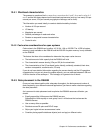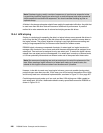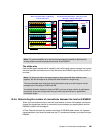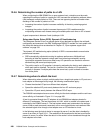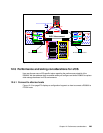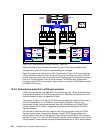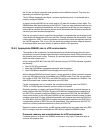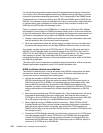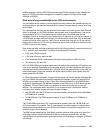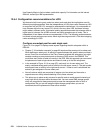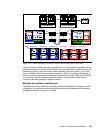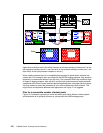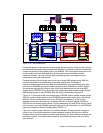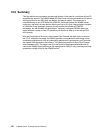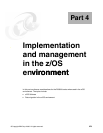Chapter 12. Performance considerations 273
Another example, with four ESS F20s each with eight FICON channels, might collapse into
about 20 FICON ports when changing to a connectivity speed of 2 Gbps for the target
DS8100 or DS8300.
Disk array sizing considerations for z/OS environments
You can determine the number of ranks required not only based on the needed capacity, but
also depending on the workload characteristics in terms of access density, read to write ratio,
and hit rates.
You can approach this from the disk side and look at some basic disk figures. Fibre Channel
disks, for example, at 10k RPM provide an average seek time of approximately 5 ms and an
average latency of 3 ms. For transferring only a small block, the transfer time can be
neglected. This is an average 8 ms per random disk I/O operation or 125 I/Os per second. A
15k RPM disk provides about 200 random I/Os per second for small block I/Os. A combined
number of 8 disks is then good for 1,600 I/Os per second when they spin at 15k per minute.
Reduce the number by 12.5% when you assume a spare drive in the 8 pack. Assume further
a RAID-5 logic over the 8 packs.
Back at the host side, consider an example with 4,000 I/Os per second, a read to write ratio of
3 to 1, and 50% read cache hits. This leads to the following I/O numbers:
3,000 read I/Os per second.
1,500 read I/Os must read from disk.
1,000 writes with RAID-5 and assuming the worst case results in 4,000 disk I/Os.
This totals to 4,500 disk I/Os.
With 15K RPM DDMs you need the equivalent of three 8 packs to satisfy the I/O load from the
host for this example. Depending on the required capacity, you then decide the disk capacity,
provided each desired disk capacity has 15k RPM. When the access density is less and you
need more capacity, follow the example with higher capacity disks, which usually spin at a
slower speed like 10k RPM.
In “Fibre Channel device adapter” on page 260 we stated that the disk storage subsystem DA
port in a DS8000 has about five times the sequential throughput capability of what an ESS
800 DA port provides. Based on the 2 Gbps Fibre Channel connectivity to a DS8000 disk
array this is approximately 200 MB/sec compared to the SSA port of an ESS disk array with
40 MB/sec. A Fibre Channel RAID array provides an external transfer rate of over 200
MB/sec. The sustained transfer rate varies. For a single disk drive, various disk vendors
provide on their internet product sites the following numbers:
146 GB DDM with 10K RPM deliver a sustained transfer rate between 38 and 68 MB/sec
or 53 MB/sec on average.
73 GB DDM with 15K RPM transfers between 50 and 75 MB/sec or 62.5 MB/sec on
average.
The 73 GB DDMs have about 18% more sequential capability than the 146 GB DDM, but
60% more random I/O potential. The I/O characteristic is another aspect to consider when
deciding the disk and disk array size. While this discussion is theoretical in approach, it is
sufficient to get a first impression.
The IBM internal modelling tool, Disk Magic provides numbers which prove to be more firm.
Disk Magic helps to model configurations based on customer workload data. An IBM
representative can contact support personnel who will use Disk Magic to configure a DS8000
accordingly.



